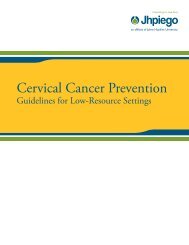Manual for Male Circumcision under Local Anaesthesia
Manual for Male Circumcision under Local Anaesthesia
Manual for Male Circumcision under Local Anaesthesia
Create successful ePaper yourself
Turn your PDF publications into a flip-book with our unique Google optimized e-Paper software.
<strong>Male</strong> circumcision <strong>under</strong> local anaesthesia<br />
Version 3.1 (Dec09)<br />
Counsellor’s empathic response: “So you often feel irritated,<br />
uncom<strong>for</strong>table, and pressured by your girlfriend. That must be<br />
difficult <strong>for</strong> you.”<br />
Active listening<br />
Active listening involves paying attention to what a client says and<br />
does, in a way that shows respect, interest and empathy. Active<br />
listening is more than just hearing what clients say. It is paying<br />
attention to the content of the message, as well as the client’s feelings<br />
and worries that show through his movements, tone of voice, facial<br />
expressions, and posture.<br />
Example:<br />
The client looks very nervous and is biting his nails, but tells the<br />
counsellor he is fine.<br />
Counsellor: “Sometimes when we think we are relaxed, we can still<br />
feel quite anxious inside. I see you are biting your nails. Perhaps<br />
something is bothering you that you do not know how to express.<br />
Do you have any idea what that might be”<br />
Open questioning<br />
Open questions are questions that require more than a one-word<br />
answer. They usually begin with words such as “how”, “what” or “why”.<br />
Open questions encourage clients to express their feelings and share<br />
in<strong>for</strong>mation about their situation.<br />
Examples:<br />
“Why have you decided to come <strong>for</strong> male circumcision”<br />
“How do you think circumcision can reduce your risk of STI or HIV<br />
infection”<br />
“What do you do that may make it possible <strong>for</strong> you to get infected<br />
with an STI or HIV”<br />
“What are you currently doing to protect yourself against STIs and<br />
HIV How is this working”<br />
Probing<br />
Probing is using questions to help clients express themselves more<br />
clearly. Probing is necessary when the counsellor needs more<br />
in<strong>for</strong>mation about the client’s feelings or situation. Asking a probing<br />
question is a good way to follow up on a question that has been<br />
answered by “yes” or “no.”<br />
Examples:<br />
“Can you tell me more about that”<br />
“How do you feel about that”<br />
Educating and Counselling Clients and Obtaining In<strong>for</strong>med Consent Chapter 3-7
















